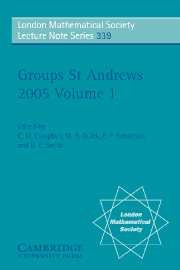Book contents
- Frontmatter
- Contents
- Introduction
- Aspects of infinite permutation groups
- Self-similarity and branching in group theory
- On surface groups: motivating examples in combinatorial group theory
- Nilpotent p-algebras and factorized p-groups
- Classification of finite groups by the number of element centralizers
- Algorithmic use of the Mal'cev correspondence
- Minimal but inefficient presentations for semi-direct products of finite cyclic monoids
- The modular isomorphism problem for finite p-groups with a cyclic subgroup of index p2
- On one-generated formations
- New results on products of finite groups
- Radical locally finite T-groups
- Explicit tilting complexes for the Broué conjecture on 3-blocks
- Conjugacy classes of p-regular elements in p-solvable groups
- An algorithm for the unit group of the Burnside ring of a finite group
- Integral group ring of the first Mathieu simple group
- Embedding properties in direct products
- Malcev presentations for subsemigroups of groups — a survey
- Finite groups with extremal conditions on sizes of conjugacy classes and on degrees of irreducible characters
- Conjugacy class structure in simple algebraic groups
- On automorphisms of products of groups
- Linear groups with infinite central dimension
- G-automata, counter languages and the Chomsky hierarchy
- An embedding theorem for groups universally equivalent to free nilpotent groups
- Irreducible word problems in groups
- Recent growth results
Linear groups with infinite central dimension
Published online by Cambridge University Press: 07 May 2010
- Frontmatter
- Contents
- Introduction
- Aspects of infinite permutation groups
- Self-similarity and branching in group theory
- On surface groups: motivating examples in combinatorial group theory
- Nilpotent p-algebras and factorized p-groups
- Classification of finite groups by the number of element centralizers
- Algorithmic use of the Mal'cev correspondence
- Minimal but inefficient presentations for semi-direct products of finite cyclic monoids
- The modular isomorphism problem for finite p-groups with a cyclic subgroup of index p2
- On one-generated formations
- New results on products of finite groups
- Radical locally finite T-groups
- Explicit tilting complexes for the Broué conjecture on 3-blocks
- Conjugacy classes of p-regular elements in p-solvable groups
- An algorithm for the unit group of the Burnside ring of a finite group
- Integral group ring of the first Mathieu simple group
- Embedding properties in direct products
- Malcev presentations for subsemigroups of groups — a survey
- Finite groups with extremal conditions on sizes of conjugacy classes and on degrees of irreducible characters
- Conjugacy class structure in simple algebraic groups
- On automorphisms of products of groups
- Linear groups with infinite central dimension
- G-automata, counter languages and the Chomsky hierarchy
- An embedding theorem for groups universally equivalent to free nilpotent groups
- Irreducible word problems in groups
- Recent growth results
Summary
Abstract
The authors report recent work concerning infinite dimensional linear groups with various finiteness conditions on subgroups of infinite central dimension.
Introduction
In this paper we give a survey of recent work of the authors and others. We recall that a group G that is isomorphic to a group of automorphisms of a vector space A over a field F is called a linear group and we denote the group of all such automorphisms by GL(F,A). If dimFA, the dimension of A over F, is finite, n say, then we say that G is a finite dimensional linear group and it is then well-known that GL(F,A) can be identified with the group of n × n matrices with entries in F. From the outset, finite dimensional linear groups have played an important role in mathematics. This is partly due to the correspondence mentioned above, but also because of the rich interplay between geometrical and algebraic ideas associated with such groups.
The study of the subgroups of GL(F,A) in the case when A is infinite dimensional over F has been much more limited and normally requires some additional restrictions. The circumstances here are similar to those present in the early development of Infinite Group Theory. One approach there consisted in the application of finiteness conditions to the study of infinite groups.
- Type
- Chapter
- Information
- Groups St Andrews 2005 , pp. 306 - 312Publisher: Cambridge University PressPrint publication year: 2007
- 4
- Cited by

